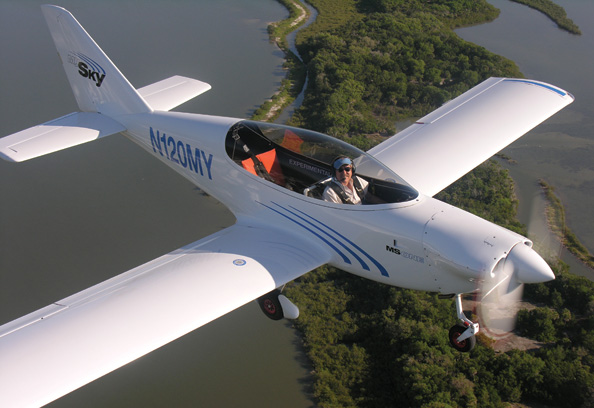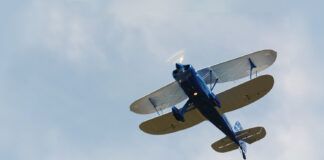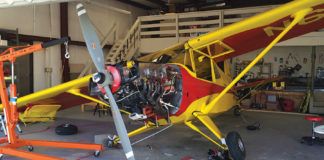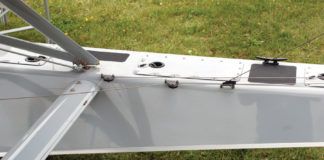
At first glance, the thought of combining the design constraints of a Light Sport Aircraft (LSA) with the ambiance of a military fighter seems like an impossible stretch. But that idea actually becomes conceivable when you first see and then fly the MySky MS-1 from a company near Daytona Beach, Florida.
The trick is put together an airplane with the LSA limits such as fixed gear, fixed-pitch propeller, 120-knot maximum level speed, maximum gross weight of 1320 pounds and 45-knot maximum clean airspeed with something that will excite pilot/owners as it resembles a tiny fighter-not only from the external view, but on the panel, in the controls and in fighter-like handling.
My MS-1 flight last winter at Sebring, Florida, indicates that the company is on its way toward the goal, and improvements since then are being fitted now. Also in the works are Experimental/Amateur-Built versions, which would avoid the LSA restrictions. A jet-powered MySky is being planned.
The Current Model
Company President Dieter Canje confirmed that the prototype MS-1 I flew is a work in progress. Based on a concept by California designer Martin Hollmann, the MS-1 is an all-composite, tandem-configuration two-seater. The large single-piece bubble canopy hinges at the rear like an F/A-18 Super Hornet or, if you’re a fan of 1970s naval aviation, like the swing-wing F-14A Tomcat. (My preferred reference is the Tomcat, as I logged 25 hours years ago in F-14 rear seats in the Navys test and evaluation community.)
The MySky MS-1 is powered by a Jabiru 3300, the six-cylinder, direct-drive engine from Australia that produces 120 horsepower at 3300 rpm and 107 hp at the approved continuous 2750 rpm. It is coupled with a Sensenich ground-adjustable composite propeller.
Features include electric elevator pitch trim and electric flaps (0, 10, 30), differential braking with nosewheel castering, and Grove Aircraft aluminum spring maingear legs.
The fighter-like ambience is strongest when you board and settle into the cushioned seat, position your right hand on the sculpted side-stick, and grasp the throttle with the left hand. Depending on the MS-1 instrument package ordered, both cockpits can offer the MySky Flight Information System, a flat-panel programmable combination of an electronic flight instrument system (EFIS), engine and systems monitoring, and GPS that displays computer-generated terrain.

MySky demo pilot Bob Gandt poses with the new MS-1.
Demo Pilot
I flew with Bob Gandt, whose past and present aviation accomplishments fit perfectly with the MS-1 image. Shortly before the Vietnam War, Gandt flew tiny single-seat A-4 attack jets from small-deck carriers. Leaving the Navy in 1965, he signed on with Pan Am and advanced to captain.
With a lifelong interest in writing, he wrote four novels about the skipper of an F/A-18 Super Hornet squadron aboard the USS Ronald Reagan (one of our newer carriers) and four non-fiction books on subjects from training to become a fighter pilot, the age of flying boats, the Reno Air Races, and the rise and fall of Pan Am. He is currently working on a script for a movie adaptation of one of his books, all of which are still available.
Flying the MS-1
My introduction to the airplane was in the grass along the temporary LSA runway at Sebring Regional Airport. As with many composite airplanes, the MS-1 offers little to inspect on a walk-around. Ducking under the sill of the rear-hinged canopy into the rear cockpit, my thought was of boarding an F-14. Both MS-1 cockpits are far roomier than the pit of a Navy A-4. Another difference, soon to be appreciated, is that unlike the old Navy two-seat fighters (F-4s and F-14s), the MS-1 rear cockpit has flight controls.
Jabiru startup is simple. With avionics online, we called Sebrings temporary tower for taxi to the general aviation apron and for takeoff on Runway 36. With flaps set for takeoff and clearance from the tower, Gandt suggested I make the takeoff, noting that considerable right rudder is needed on departure. He was right. A bootful of rudder on the roll and then a steady 5 pounds or so at best climb speed countered p-factor, keeping the electronic slip/skid ball near the center.
With the proper pitch trim setting (conveniently selected by a switch on the sidestick), elevator control force was somewhat higher than I expected, and considerably higher lateral force was needed to bank and to roll wings level. (The factory notes that the current mod program includes lightening roll control substantially.) In effect, all three axes required somewhat higher forces than other LSAs Ive flown.
How about roll rate? My subjective but always consistent technique is to roll gently into a level 45 bank at cruise airspeed and then count the seconds from 45 one way to 45 in the other. I do it both directions, and the number noted was 3.5 seconds-about 1 second longer than most LSAs. Discussing this with MySkys president, we pondered whether the heavy ailerons could slow the time to get to full aileron deflection, and that is certainly possible. Its likely that lighter, more effective ailerons will improve the roll rate.
At the time, I attributed the slightly low roll rate to an unusual and (for the LSA version of the MS-1) detrimental feature: The prototype I flew was fitted with a wing designed and tested to 10 G. Wow! With LSA design load standards set at 4 G (plus a 50% safety factor before breaking or permanent bending), why would you design a heavier wing that gives up performance in every way (climb rate, cruise speed and efficiency, and useful load)?
The answer is that the heavier wing is intended for later Experimental-category kits where neither maximum airspeed nor gross weight is defined. With a larger engine (possibly even a jet) and aerobatic intentions, Id want the 10-G wing. MySky confirms that the LSA MS-1 will have a lighter wing when it is ready for market.
Other checks included a 113-knot maximum level speed at 3000 rpm (which is just above the continuous-power 2750 rpm Jabiru guidance). Departure stalls with the ball in the center (the recommended place for it) demonstrated a mush at 54 knots, and the clean approach stall was docile near 46 knots indicated. Visibility in all directions with that canopy was, of course, outstanding.
I used 80 knots in the pattern, slowing to 70 on final. Control feel was solid and comfortable. The MS-1 handles a crosswind well with the upwind maingear touching down first if necessary. Differential brakes and a castering nosewheel make the airplane a joy to taxi.
Summary
The MS-1 is a work in progress with great potential. Although not ready for FAA LSA approval or distribution, I was assured that all issues noted are being addressed. Sometime soon, MS-1 owners are going to be delighted with their mini fighters.
For more information, call 386/492-6909 or visit www.mysky.aero.




